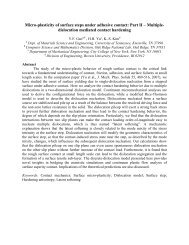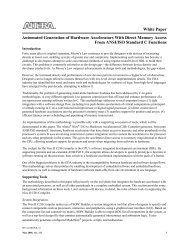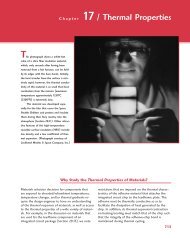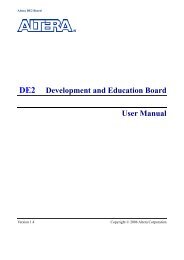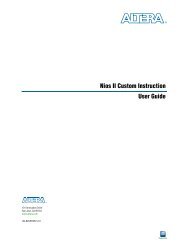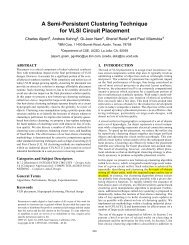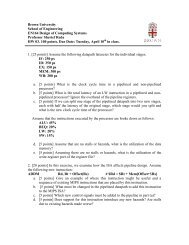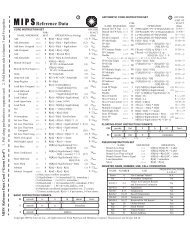HW5 - Brown University
HW5 - Brown University
HW5 - Brown University
You also want an ePaper? Increase the reach of your titles
YUMPU automatically turns print PDFs into web optimized ePapers that Google loves.
<strong>Brown</strong> <strong>University</strong><br />
School of Engineering<br />
EN164 Design of Computing Systems<br />
Professor Sherief Reda<br />
HW 05. 120 points. Due Date: Tuesday, May 1 st in class.<br />
1. [30 points] The following core is written in C, where elements within the same row are<br />
stored contiguously<br />
for (J = 0; J < 8000; J++) <br />
for (I = 0; I < 8; I++) <br />
A[I][J] = B[I][0] + A[J][I]; <br />
a. [5 points] How many 32-bit integers can be stored in a 16-byte cache line?<br />
b. [5 points] References to which variables exhibit temporal locality?<br />
c. [5 points] References to which variables exhibit spatial locality?<br />
Locality is affected by both the reference order and data layout. The same computation<br />
can also be written below in Matlab, which differs from C by contiguously storing matrix<br />
elements within the same column.<br />
for J = 1:8000 <br />
for I = 1:8 <br />
A(I, J) = B(I, 0) + A(J, I); <br />
end <br />
end <br />
d. [5 points] How many 16-byte cache lines are needed to store all 32-bit matrix elements<br />
being referenced?<br />
e. [5 points] References to which variables exhibit temporal locality?<br />
f. [5 points] References to which variables exhibit spatial locality?<br />
2. [30 points] For a direct-mapped cache design with 32-bit address, the following bits of<br />
the address are used to access the cache. Tag: 31-12, Index: 11-6, and Offset: 5-0.<br />
a. [5 points] What is the cache line size (in words)?<br />
b. [5 points] How many entries does the cache have?<br />
c. [5 points] What is the ratio between the total bits required for such a cache<br />
implementation over the data storage bits?
Starting from the power on, the following byte-addressed cache references are recorded<br />
Address: 0, 4, 16, 132, 232, 160, 1024, 30, 140, 3100, 180, 2180.<br />
d. [5 points] How many blocks are replaced?<br />
e. [5 points] What is the hit ratio?<br />
f. [5 points] List the final state of the cache, with each valid entry represented as a record<br />
of .<br />
3. [15 points] Assume the following address stream:<br />
3, 180, 43, 2, 191, 88, 190, 14, 181, 44, 186, 253<br />
a. [5 points] Show the final cache contents for a three-way set associate cache with twoword<br />
blocks and a total size of 24 words. Use the LRU replacement. For each reference<br />
identify the index bits, the tag bits, the block offset bits, and if it is a hit or a miss.<br />
b. [5 points] Show the final cache contents for a fully associate cache with one-word<br />
blocks and a total size of 8 words. Use LRU replacement. For each reference, identify the<br />
index bits, the tag bits, and if it is a hit or a miss.<br />
c. [5 points] What is the miss rate for a fully associate cache with two-word blocks and a<br />
total size of 8 words, using LRU replacement? What is the miss rate using MRU (most<br />
recently used) replacement? Finally what is the best possible miss rate for this cache,<br />
given any replacement policy?<br />
4. [25 points] A x16 DRAM device has a total capacity of 128 KB (kilobytes). Assume<br />
that the memory array is square in size.<br />
a. What is the size of the row decoder?<br />
b. What is the size of the column decoder?<br />
c. What is the number of output data bits?<br />
d. Assume you have a number of these DRAM devices available. Explain, with<br />
diagrams, how to connect these devices to create a memory system of total<br />
capacity of 1 MB with a data bus of 32 bits. Make sure to show the<br />
connections of the address bus to the DRAM devices. What is the address<br />
subspace that is covered by each device?
5. [10 points] Consider a memory system with the following parameters:<br />
• Translation Lookaside Buffer has 512 entries and is 2-way set associative.<br />
• 64Kbyte L1 Data Cache has 128 byte lines and is also 2-way set associative.<br />
• Virtual addresses are 64-bits and physical addresses are 32 bits.<br />
• 8KB page size Below are diagrams of the cache and TLB. Please fill in the<br />
appropriate information in the table that follows the diagrams:<br />
6. [10 points] There are several parameters that impact the overall size of the page table.<br />
Listed below are several key page table parameters.<br />
Virtual address size: 32 bits<br />
Page size: 4 KB (kilobyte)<br />
Page Table Entry Size (4 bytes)<br />
a. [5 points] Calculate the total page table size for a system running 5 applications that<br />
utilize half of the memory available.<br />
b. [5 points] A cache designer wants to increase the size of a 4 KB virtually indexed,<br />
physically tagged cache. Given the page size parameter above, is it possible to make a 16<br />
KB direct-mapped cache assuming 2 words per block? How would the designer increase<br />
the data size of the cache?



